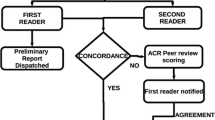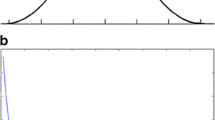Abstract
Purpose
To evaluate the feasibility of adding pathology to recent radiologist error characterization schemes of modality and anatomic region and the potential of this data to more specifically inform peer review and peer learning.
Methods
Quality assurance data originating from 349 radiologists in a national teleradiology practice were collected for 2019. Interpretive errors were simply categorized as major or minor. Reporting or communication errors were classified as administrative errors. Interpretive errors were then divided by modality, anatomic region and placed into one of 64 pathologic categories.
Results
Out of 1,628,464 studies, the discrepancy rate was 0.5% (8181/1,634,201). The 8181 total errors consisted of 2992 major errors (0.18%) and 5189 minor errors (0.32%). Precisely, 3.1% (257/8181) of total errors were administrative. Of major interpretive errors, 75.5% occurred on CT, with CT abdomen and pelvis accounting for 40.4%. The most common pathologic discrepancy for all exams was in the category of mass, nodule, or adenopathy (1583/8181), the majority of which were minor (1315/1583). The most common pathologic discrepancy for the 2937 major interpretive errors was fracture or dislocation (27%; 793/2937), followed by bleed (10.7%; 315/2937).
Conclusion
The addition of error-related pathology to peer review is both feasible and practical and provides a more detailed guide to targeted individual and practice-wide peer learning quality improvement efforts. Future research is needed to determine if there are measurable improvements in detection or interpretation of specific pathologies following error feedback and educational interventions.

Similar content being viewed by others
References
Larson DB, Donnelly LF, Podberesky DJ, Merrow AC, Sharpe RE Jr, Kruskal JB (2017) Peer feedback, learning and improvement: answering the call of the Institute of Medicine report on diagnostic error. Radiology 283:231–241
Chaudhry H, Gaizo AJD, Frigini LA, Goldberg-Stein S, Long SD, Metwalli ZA, Morgan JA, Nguyen XV, Parker MS, Abujudeh H (2020) Forty-one million RADPEER reviews later: what we have learned and are still learning. J Am Coll Radiol 17:779–785
Bruno MA, Walker EA, Abujudeh HH (2015) Understanding and confronting our mistakes: the epidemiology of error in radiology and strategies for error reduction. Radiographics 35(6):1668–76. https://doi.org/10.1148/rg.2015150023
Fitzgerald R (2001) Error in radiology. Clin Radiol 56(12):938–946. https://doi.org/10.1053/crad.2001.0858
FitzGerald R (2005) Radiological error: analysis, standard setting, targeted instruction and teamworking. Eur Radiol 15(8):1760–1767. https://doi.org/10.1007/s00330-005-2662-8
Waite S, Scott J, Gale B, Fuchs T, Kolla S, Reede D (2016) Interpretive error in radiology. AJR Am J Roentgenol 2016:1–11. https://doi.org/10.2214/AJR.16.16963
Wu MZ, McInnes MD, Macdonald DB, Kielar AZ, Duigenan S (2014) CT in adults: systematic review and meta-analysis of interpretation discrepancy rates. Radiology 270(3):717–735. https://doi.org/10.1148/radiol.13131114
Soffa DJ, Lewis RS, Sunshine JH, Bhargavan M (2004) Disagreement in interpretation: a method for the development of benchmarks for quality assurance in imaging. J Am Coll Radiol 1(3):212–217. https://doi.org/10.1016/j.jacr.2003.12.017
Hanna TN, Loehfelm T, Khosa F, Rohatgi S, Johnson JO (2016) Overnight shift work: factors contributing to diagnostic discrepancies. Emerg Radiol 23(1):41–47. https://doi.org/10.1007/s10140-015-1355-0
Donald JJ, Barnard SA (2012) Common patterns in 558 diagnostic radiology errors. J Med Imaging Radiat Oncol 56:173–178
Goldberg-Stein S, Frigini LA, Long S et al (2017) ACR RADPEER Committee white paper with 2016 updates: revised scoring system, new classifications, self-review, and subspecialized reports. J Am Coll Radiol 14:1080–1086
Abujudeh H, Pyatt RS Jr, Bruno MA et al (2014) RADPEER peer review: relevance, use, concerns, challenges, and direction forward. J Am Coll Radiol 11:899-904.13
Hanna TN, Lamoureux C, Krupinski EA, Weber S, Johnson JA (2018) Effect of shift, schedule, and volume on interpretive accuracy: a retrospective analysis of 2.9 million radiologic examinations. Radiology 287(1):205–212
Renfrew DL, Franken EA Jr, Berbaum KS, Weigelt FH, Abu-Yousef MM (1992) Error in radiology: classification and lessons learned in 182 cases presented at a problem case conference. Radiology 183:145–150
Kim YW, Mansfield LT (2014) Fool me twice: delayed diagnoses in radiology with emphasis on perpetuated errors. AJR 202:465–470
Berlin L (2007) Radiologic errors and malpractice: a blurry distinction. AJR 189:517–522
Kostrubiak DE, DeHay PW, Ali N, D’Agostino R, Keating DP, Tam JK, Akselrod DG (2020) Body MRI subspecialty reinterpretations at a tertiary care center: discrepancy rates and error types. AJR 215(6):1384–1388
Goradia D, Blackmore CC, Talner LB, Bittles M, Meshberg M (2005) Predicting radiology resident errors in diagnosis of cervical spine fractures. Acad Radiol 12(7):888–893
Pinto A, Berritto D, Russo A, Riccitiello F, Caruso M, Belfiore MP, Papapietro VR, Carotti M, Pinto F, Giovagnoni A, Romano L, Grassi R (2018) Traumatic fractures in adults: missed diagnosis on plain radiographs in the Emergency Department. Acta Biomed 89(Suppl 1):111–123
Pinto A, Brunese L (2010) Spectrum of diagnostic errors in radiology. World J Radiol 2:377–383
Pekrum R, Cusack A, Murayama K, Elliot AJ, Thomas K (2014) The power of anticipated feedback: effects on students’ achievement goals and achievement emotions. Learn Instr 29:115–124
Hattie J, Timperly H (2007) The power of feedback. Rev Educ Res 77(1):81–112
Bender LC, Linnau KF, Meier EN, Anzai Y, Gunn ML (2012) Interrater agreement in the evaluation of discrepant imaging findings with the RADPEER system. Am J Roentgenol199(6):1320–1327
Author information
Authors and Affiliations
Contributions
All authors contributed to the study conception and design. Material preparation, data collection, and analysis were performed by Christine Lamoureux, MD; Edward Callaway, MD; Devin Sprecher; and Scott Weber, BA. The first draft of the manuscript was written by Christine Lamoureux, MD, and all authors commented on previous versions of the manuscript. All authors read and approved the final manuscript.
Corresponding author
Ethics declarations
Conflict of interest
The authors declare that they have no conflict of interest.
Additional information
Publisher's note
Springer Nature remains neutral with regard to jurisdictional claims in published maps and institutional affiliations.
Rights and permissions
About this article
Cite this article
Lamoureux, C., Hanna, T.N., Sprecher, D. et al. Radiologist errors by modality, anatomic region, and pathology for 1.6 million exams: what we have learned. Emerg Radiol 28, 1135–1141 (2021). https://doi.org/10.1007/s10140-021-01959-6
Received:
Accepted:
Published:
Issue Date:
DOI: https://doi.org/10.1007/s10140-021-01959-6




